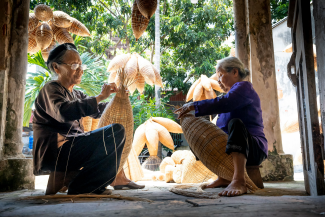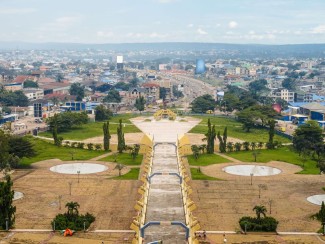Resilience is necessary in the rice trade, developing it requires many
About 80% of Cambodians are rural farmers, and rice is the country’s main crop. But, until the last decade or so, the sector had not been living up to its potential.
Doing so would mean more productive harvests, better incomes for impoverished farmers, more local businesses involved in exporting and greater competitiveness in the global rice marketplace. The country is now seeing success cultivating this potential, which has involved government strategy and planning, international support and the resourcefulness of locals.
“Our rice farmers face difficulties with having sufficient irrigation systems, fertilizers and safe pesticides. After harvesting, they face issues with knowing market prices and bringing their products to potential markets. And they are heavily dependent on the collectors and domestic buyers,” said Deputy Director General for International Trade Kemvichet Long.
For local exporters, challenges include an irregular supply, the logistics of getting rice to destination markets and meeting required international sanitary and phytosanitary measures, Long said.
Amru Rice offers one example of how some of these challenges can be addressed. The Cambodian enterprise was founded in 2011 to trade in rice, at a time when Cambodia and the European Union had agreed to the Everything But Arms initiative that allows for direct exports to Europe.
Today, the family business works with farmers and sells to buyers local and abroad, and it has received support from the country’s Ministry of Trade, the global impact investing firm responsAbility and through a joint program of the Enhanced Integrated Framework (EIF), the European Union and the International Financial Corporation (IFC) to support SMEs in the country’s agro-industry, among other international institutions.
Seeing that farmers had the dual struggles of finding buyers and getting good prices, Amru started contract farming in 2014 with about 100 farmers from a minority ethnic group in the country’s highlands. Select farmers were given more marketable paddy seed and assured of a fair price for their harvests, purchased by Amru. The scheme was a success that first year, and it took off from there.
“By 2020, in the sixth year, we had 10,000 farmer families based in 11 provinces throughout the country producing 45,000 tons of organic rice,” said Song Saran, CEO of Amru Rice.
“We understood the weaknesses and we adapted to farmers’ traditional ways, and we worked to change behavior over time, as needed,” he said. “We want them to be able to become entrepreneurs if they want, and know the demand and the supply.”
On the flip side, the government worked to facilitate the work of rice exporters like Amru, including by allowing for the faster clearance of goods at borders, reducing shipping and logistics costs and introducing an online system for managing value-added tax.
These moves created an environment in Cambodia where the rice sector, and its farmers, collectors, buyers and exporters, could thrive.
For Amru, initial capital funding of US$1.5 million from responsAbility in 2014 helped them to grow, especially as they didn’t have sufficient local financing. The investment helped the company to move into sales of more profitable organic rice – now 50% of the business – and Amru now finances working capital through local financing.
ResponsAbility investments target sustainable impacts, and their partnership with Amru has progressed from the business’ very first investment to supporting Amru in providing farmer trainings through dedicated technical assistance projects alongside the provision of long-term financing for expansion.
“In terms of economic benefit, our technical assistance project targeted a 15% increase in productivity of the farm and 15% increase in income of the farmer. These are the parameters we've been tracking,” said Neha Baid, Senior Investment Officer at responsAbility.
“We work with a lot of small businesses that are very close to the farm, and where we can see a direct benefit to smallholder farmers, that's a key focus area for us,” she said.
Recognizing that farmers were dependent on fluctuations in rice prices and some were taking lower prices because they had no other options, Amru has helped farmers create cooperatives so they can better profit from their harvests and even move into the processing side.
These kinds of efforts, from government support in the form of trade facilitation to injections of capital to direct work with rice farmers helped to build up a lot of resilience, and spurred a threefold increase in Cambodia’s rice exports between 2011 and 2016.
COVID-19 struck a blow, with local restaurants closed and therefore not ordering rice, and international buyers also cutting purchasing. The entire supply chain was affected, as were many others.
“For me, it's grappling with how I can promote and sell more rice. The big disruption for me at the moment is freight, shipping lines have increased their prices. The cost for a container has gone up three or four times, and this has a big impact on income,” Saran said.
Most of his exports go to the European Union, where he sells fragrant rice, red rice, jasmine rice, medium grain rice, black rice, or approximately seven different varieties. But there are strong competitors from the many other rice-producing countries.
The government is continuing to build on its efforts to assist farmers and exporters, including improving cultivation techniques and processing facilities, particularly for rice millers.
“Post harvesting, drying, milling, packaging and labelling are crucial for our plan,” Long said.
The government is also working on the financing side, and providing direct support to impacted farmers.
“To support further access to finance, the government has launched SME Bank of Cambodia and the Agriculture and Rural Development Bank catering to the needs of Cambodian SME businesses and agriculture producers and exporters, respectively. The RGC is also currently implementing a series of measures aimed at mitigating the impacts of COVID-19 on businesses and workers in Cambodia,” said Long.
Amru’s Saran is working with farmers to diversify beyond just rice into other high profit items like black pepper, cassava and cashews. And he is thinking about new markets for processed rice items like syrups and baby food.
“If another crisis comes in the next 4-5 years I think we will be more prepared, because I believe in my supply chain. At the moment we are not yet at our peak, for example other countries can produce 3-4 tons of rice per hectare, but we can only do 2 or 2.5 tons per hectare. We still need more training to ensure more skills to get more productivity. But I know we’ll be ready,” Saran said.
If you would like to reuse any material published here, please let us know by sending an email to EIF Communications: eifcommunications@wto.org.


